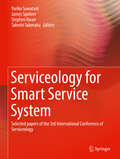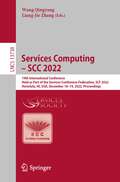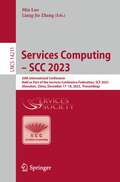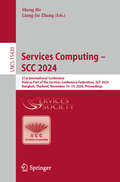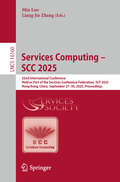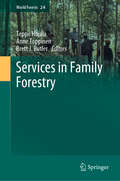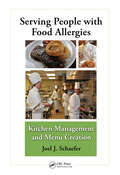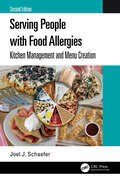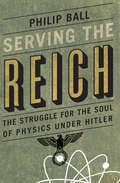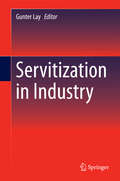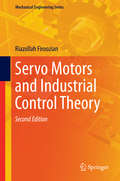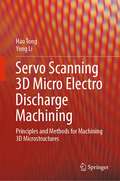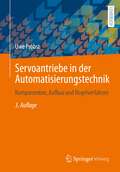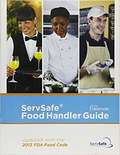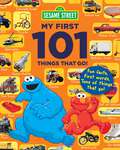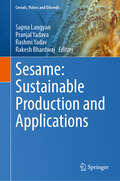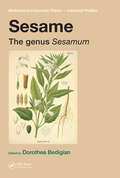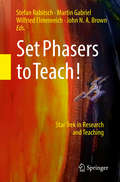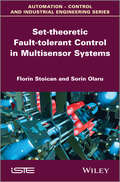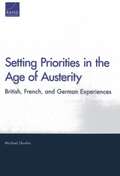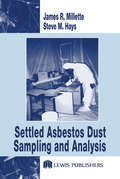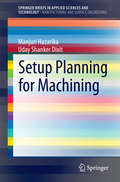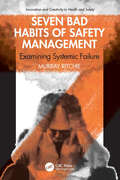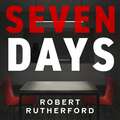- Table View
- List View
Serviceology for Smart Service System: Selected papers of the 3rd International Conference of Serviceology
by Yuriko Sawatani Takeshi Takenaka James Spohrer Stephen KwanServices are key activities in a globalized economy and they also underlie the quality of life of local residents. The advanced work presented in this book was selected from the proceedings of the Third International Conference on Serviceology (ICServ2015), held July 7–9, 2015, in San Jose, CA, USA. The conference was supported by the Society for Serviceology. The society was established in 2012 in Japan to explore the scientific systematization of services and to promote technological developments for solutions to industrial issues.This book provides a useful general guide to the state of the art in the theory and practice of services. It can also serve as a valuable reference book for researchers in a wide range of fields from engineering to marketing and economics.
Services Computing – SCC 2022: 19th International Conference, Held as Part of the Services Conference Federation, SCF 2022, Honolulu, HI, USA, December 10–14, 2022, Proceedings (Lecture Notes in Computer Science #13738)
by Liang-Jie Zhang Wang QingyangThis volume constitutes the proceedings of the 19th International Conference on Services Computing 2022, SCC 2022, held as part of SCF 2022 during December 10-14, 2022 in Honolulu, USA.The 8 full papers and 1 short paper presented in this volume were carefully reviewed and selected from 15 submissions. It covers the science and technology of leveraging computing and information technology to model, create, operate, and manage business services.
Services Computing – SCC 2023: 20th International Conference, Held as Part of the Services Conference Federation, SCF 2023, Shenzhen, China, December 17–18, 2023, Proceedings (Lecture Notes in Computer Science #14211)
by Liang-Jie Zhang Min LuoThis book constitutes the refereed proceedings of the 20th International Conference on Services Computing, SCC 2023, held in Shenzhen, China, during December 17–18, 2023.The 6 full papers in this book were carefully reviewed and selected from 18 submissions. They are organized in topical sections as follows: business modeling, business consulting, solution creation, service delivery, and software architecture design, development, and deployment.
Services Computing – SCC 2024: 21st International Conference, Held as Part of the Services Conference Federation, SCF 2024, Bangkok, Thailand, November 16-19, 2024, Proceedings (Lecture Notes in Computer Science #15430)
by Liang-Jie Zhang Sheng HeThis book constitutes the refereed proceedings of the 21st International Conference on Services Computing – SCC 2024, Held as Part of the Services Conference Federation, SCF 2024, held in Bangkok, Thailand, during November 16-19, 2024. The 7 full papers in this book were carefully reviewed and selected from 13 submissions. They are organized in topical sections as follows: business modeling, business consulting, solution creation, service delivery, and software architecture design, development, and deployment.
Services Computing – SCC 2025: 22nd International Conference, Held as Part of the Services Conference Federation, SCF 2025, Hong Kong, China, September 27–30, 2025, Proceedings (Lecture Notes in Computer Science #16160)
by Liang-Jie Zhang Min LuoThis book constitutes the refereed proceedings of the 22nd International Conference on Services Computing – SCC 2025, Held as Part of the Services Conference Federation, SCF 2025, held in Hong Kong, China during September 27–30, 2025. The 7 full papers included in this book were carefully reviewed and selected from 11 submissions. The papers focus on the latest fundamental advances in the state of the art and practice of business modeling, business consulting, solution creation, service delivery, and software architecture design, development, and deployment.
Services in Family Forestry (World Forests #24)
by Teppo Hujala Anne Toppinen Brett J. ButlerThis book transfers the newest service research concepts, such as value co-creation, to family forestry context. The book is aimed at as learning material for higher-education students in Western economies, and as a handbook for forest scientists worldwide. It has a strong theoretical base, but also a practical orientation with examples of novel forest services from different regions and contexts. The five parts of the book are: I Conceptualization of Service Approaches in Family Forestry; II Market and Policy Environment; III Public Service and Business Innovations; IV Communication, Cooperation, and Organizations for Services; and V Transitions Governance. Each part begins with a chapter that is more conceptual and thus sets the stage for the subsequent chapters, which then focus on a regional perspective or some more specific theme under the part’s coverage.
Serving People with Food Allergies: Kitchen Management and Menu Creation
by Joel J. SchaeferAn increasing number of people have food allergies or require special diets, and they are dining out more often. As a food service professional, how do you accommodate the needs of these customers? Serving People with Food Allergies: Kitchen Management and Menu Creation brings together a vast store of knowledge and practical advice for people worki
Serving People with Food Allergies: Kitchen Management and Menu Creation
by Joel J. SchaeferThis book brings together a vast store of knowledge and practical advice for people working in the food service industry and contains tools for cooks, managers, and chefs to help them create and modify recipes that meet the needs of people afflicted with multiple food allergies.In the second edition of Serving People with Food Allergies: Kitchen Management and Menu Creation, food allergy statistics are updated not only for the United States but now include information about worldwide food allergy increases and the different food allergens present in various nations. It follows chef Joel’s culinary career in the industry working in a variety of operations, implementing the processes from the book’s first edition. Also new recipes, free from the top nine allergens and gluten, plus recipes meeting the latest trends in plant-based cuisine are now featured. The vetting process for receiving food products is explained in detail, including what to ask, what documents will be needed and how to handle and store these ingredients safely.Key Features Provides information on new specialty products that will enhance menu offerings and reduce liability issues Gives restaurant managers and owners ideas on how to analyze their menu to identify current options Gives college and university food service providers detailed instructions on how to arrange their operation to safely store, cook, and serve foods for their students and staff with food allergies New recipe categories and all recipes to be free of top nine food allergens with the addition of plant-based recipes
Serving the Reich: The Struggle for the Soul of Physics under Hitler
by Philip BallThis historical analysis of Heisenberg, Planck, Debye, and other German physicists during WWII &“is a stunning cautionary tale, well researched and told&” (Choice). After World War II, most scientists in Germany maintained that they had been apolitical or actively resisted the Nazi regime, but the true story is much more complicated. In Serving the Reich, Philip Ball takes a fresh look at that controversial history, contrasting the career of Peter Debye, director of the Kaiser Wilhelm Institute for Physics in Berlin, with those of two other leading physicists in Germany during the Third Reich: Max Planck, the elder statesman of physics, and Werner Heisenberg, who succeeded Debye as director of the institute when it became focused on the development of nuclear power and weapons. Mixing history, science, and biography, Ball offers a powerful portrait of moral choice and personal responsibility, as scientists navigated &“the grey zone between complicity and resistance.&” Ball&’s account of the different choices these men made shows how there can be no clear-cut answers or judgement of their conduct. Yet he also demonstrates that the German scientific establishment as a whole mounted no serious resistance to the Nazis, and in many ways acted as a willing instrument of the state. Serving the Reich considers what this problematic history can tell us about the relationship between science and politics today. Ultimately, Ball argues, a determination to present science as an abstract inquiry into nature that is &“above politics&” can leave science and scientists dangerously compromised and vulnerable to political manipulation. A CHOICE Outstanding Academic Title Award winner
Servitization in Industry
by Gunter LayThis book summarizes the "interim result" of the servitization activities in manufacturing industries. While the early literature on servitization tended to stress only its advantages, more recently, scholars have also started to refer to the challenges associated with servitization. This book attempts to give a balanced picture of servitization. The book is structured in four parts: Part I introduces the topic by presenting the most recent academic discussion about servitization and uses an empirical analysis to show the degree of servitization across Europe. The results of this analysis are then compared to the discussion in the literature. This comparison highlights the existing discrepancies between the rather euphoric literature and the more skeptical practical experience. The second and third parts attempt to explain these discrepancies by taking as a starting point the assumption that servitization recommendations have to consider the heterogeneity of the manufacturing sector and the capabilities of the provider. Part II presents articles which analyze the specific characteristics of different sectors with their barriers and potentials and presents frameworks for a successful servitization of the core sectors in European manufacturing industries which include, e. g. aeronautics, automotive, ICT, chemical industries, pulp and paper industries and different engineering sectors. Part III focuses on companies' capabilities which are necessary for successful servitization. These include strategic management, marketing, organization, innovation, engineering, human resources, controlling, quality and networks. All the contributions in parts II and III add up to a detailed picture of servitization for sectors and functions and indicate the practical implications for enterprises in manufacturing industries. The fourth part concludes the book with a chapter summarizing the findings and giving an outlook of servitization in manufacturing industries, its challenges and future developments.
Servo Motors and Industrial Control Theory
by Riazollah FiroozianServo Motors and Industrial Control Theory presents the fundamentals of servo motors and control theory in a manner that is accessible to undergraduate students, as well as practitioners who may need updated information on the subject. Graphical methods for classical control theory have been replaced with examples using mathematical software, such as MathCad and MatLab, to solve real-life engineering control problems. State variable feedback control theory, which is generally not introduced until the Masters level, is introduced clearly and simply for students to approach complicated problems and examples.
Servo Scanning 3D Micro Electro Discharge Machining: Principles and Methods for Machining 3D Microstructures
by Yong Li Hao TongThis book provides the systematic knowledge of a novel process of servo scanning 3D micro-electro-discharge machining (SS-3D micro-EDM), covering principles, methods, technologies, and optimization for machining 3D microstructures of conductive materials. The content emphasizes the systematic knowledge as well as the frontier research progress of SS-3D micro-EDM, allowing it to be used as a reference handbook for planning the whole machining process of 3D microstructures, for designing machining systems or machine tools, and even for understanding the ideas of innovative processes. The processes and the machine tools of SS-3D micro-EDM have promising applications in multi-fields for machining micro-devices or microstructures made of melt and metal alloy materials. The included methods and technologies are verified by testing and machining experiments. Thus, this book presents many machining examples, including the experimental parameters, conditions, and systems. These help the readers understand the concepts, theories, and methods easily and provide practical operation guidance for engineering applications in industrial machining processes and machine tools.
Servoantriebe in der Automatisierungstechnik: Komponenten, Aufbau und Regelverfahren
by Uwe ProbstDieses Buch erläutert Aufbau, Funktionsweise und Auslegung elektrischer Antriebe. Schwerpunkte sind die permanenterregte Synchronmaschine mit den erforderlichen Sensoren und zugehörigen Regelverfahren sowie die Anbindung über Kommunikationssysteme an die übergeordnete Steuerung.
Servsafe Essentials 5th Edition (Updated with the 2009 FDA Food Code)
by National Restaurant AssociationThis textbook has been updated to reflect the changing needs of a diverse and expanding workforce in the foodservice and restaurant industry. A significant percentage of the updates to the book were the direct result of feedback from seasoned instructors. The food safety content will create a learning experience that is activity-based and easily comprehended that will help readers prepare for examinations and will promote adherence to food safety practices in the operation.
Servsafe Food Handler Guide: Updated with the 2013 FDA Food Code
by National Restaurant National Restaurant AssociatioThe ServSafe Food Handler Guide 6th Edition easily integrates food safety into any existing onboarding training program. Sections can be completed in approximately 10 minutes. Color-coded sections for easy reference. Color photographs from the learners point of view helps reinforce food safety concepts <p><p> Enhanced assessment can be taken at the completion of training to measure if employees have the minimum competency in food safety knowledge.
Sesame Street My First 101 Things That Go (Sesame Street's My First 101 Things)
by Sky Pony PressVroom! Vroom! Help these lovable characters teach your child all about things that go in this new book from Sesame Street's My First 101 Things series! Children are always moving and love learning about things that go. With the help of Elmo, Big Bird, and other classic Sesame Street characters, you and your child will enjoy learning about 101 different things that go, from engine-run cars and trains to more unique hot air balloons and gondolas, in My First 101 Things That Go! Throughout the book, Elmo, Big Bird, Bert, Ernie, and even more of your favorite Sesame Street characters pop up to ask fun and simple questions about these things that go that will help get your child thinking about patterns and making connections to the world around them. Children are asked questions that test their knowledge of numbers, colors, patterns, and critical thinking. All the while, they just think they&’re looking at fun pictures of their favorite vehicles! Cars, trains, and other modes of transportation are always subjects that children love to read and learn about. This love of engines will have your child eager to open a book, boosted by the assistance of some of your child&’s favorite television characters. Filled with bright, full-color photographs, My First 101 Things That Go will have your child excited to learn about all sorts of vehicles and contraptions that go, go, go, just like they do!
Sesame: Sustainable Production and Applications (Cereals, Pulses and Oilseeds)
by Sapna Langyan Pranjal Yadava Rashmi Yadav Rakesh BhardwajThis edited book systematically discusses the advances in biotechnology, agrotechnology, and food technology in shaping sesame production, cultivation and uses to meet the future needs. Sesame (Sesamum indicum) is the oldest oilseed crop known to humans. It has been recognized as one of the most nutritious and health-supportive crops, with several applications in food, cosmetics, and health products. A wide variety of sesame is grown throughout the world, primarily in Asia and Africa. It’s seed and seed oil is being used widely in diverse cuisines. It is also used in cosmetic and health products. Advances in biotechnology, agrotechnology, and food technology in redefining sesame production and uses are of great importance. Various new advanced technologies have been employed to develop high yielding and disease resistant sesame varieties, for better cultivation, seed production, and for utilization of seeds and seed oil in a lot of foods, cosmetic, and health products. This book provides an overview of different advanced technologies, their mechanisms, and their effect on the quality of the sesame crop and sesame seeds/oil. The book also emphasizes the assessment of advanced technology on its limitations and advantages. This book offers the latest research on techniques, applications, and challenges of producing quality sesame crop with recommendations towards sustainable agriculture. The book is a valuable resource for students, researchers and scientists working in the field of sesame production and applications. Industry experts involved in development and management of sustainable production technologies will also find the book beneficial.
Sesame: The genus Sesamum (ISSN)
by Dorothea BedigianThe first comprehensive review of sesame and its close relative, Sesame: the genus Sesamum covers ethnographic data, modern use, linguistic analysis of sesame names from around the world, market size, export and import data, geographical sources, use in the food and cosmetic industries, and much more. The book includes a historical review of the genus Sesamum that reveals its place in present-day traditions and cultivation in Africa and Asia. Expanding coverage from archaeological and anthropological literature from India, Mesopotamia, and Egypt, this ethnobotanical monograph draws on folk sources, reviews the phytochemistry of Sesamum, and presents extensive references.
Set Phasers to Teach!: Star Trek in Research and Teaching
by Wilfried Elmenreich John N.A. Brown Stefan Rabitsch Martin GabrielFor 50 years, Star Trek has been an inspiration to its fans around the world, helping them to dream of a better future. This inspiration has entered our culture and helped to shape much of the technology of the early 21st Century.The contributors to this volume are researchers and teachers in a wide variety of disciplines; from Astrophysics to Ethnology, from English and History to Medicine and Video Games, and from American Studies to the study of Collective Computing Systems. What the authors have in common is that some version of Star Trek has inspired them, not only in their dreams of what may be, but in the ways in which they work - and teach others to work - here in the real world. Introduced with references to Star Trek films and television shows, and illustrated with original cartoons, each of the 15 chapters included in this volume provides insights into research and teaching in this range of academic fields.
Set-theoretic Fault-tolerant Control in Multisensor Systems
by Florin Stoican Sorin OlaruFault-tolerant control theory is a well-studied topic but the use of the sets in detection, isolation and/or reconfiguration is rather tangential. The authors of this book propose a systematic analysis of the set-theoretic elements and devise approaches which exploit advanced elements within the field. The main idea is to translate fault detection and isolation conditions into those conditions involving sets. Furthermore, these are to be computed efficiently using positive invariance and reachability notions. Constraints imposed by exact fault control are used to define feasible references (which impose persistent excitation and, thus, non-convex feasible sets). Particular attention is given to the reciprocal influences between fault detection and isolation on the one hand, and control reconfiguration on the other. Contents 1. State of the Art in Fault-tolerant Control 2. Fault Detection and Isolation in Multisensor Systems 3. Residual Generation and Reference Governor Design 4. Reconfiguration of the Control Mechanism for Fault-tolerant Control 5. Related Problems and Applications About the Authors Florin Stoican received a B.E. degree from the “Politehnica” University of Bucharest, Romania, in 2008 and his PhD from SUPELEC, France in 2011. He held an ERCIM Postdoctoral Fellowship with NTNU Trondheim, Norway, in 2012, and is currently Assistant Professor at “Politehnica” University of Bucharest. His main interest is the fault tolerant control of dynamical systems through the prism of set theoretic elements. His current work involves further results in set theory and constrained optimization problems. Sorin Olaru received an M.S. degree from the “Politehnica” University of Bucharest, Romania, and both his PhD and Habilitation from University Paris XI, France, being awarded the European Commission Archimedes Prize in 2002. Since 2001 he has held different positions at INRIA and SUPELEC in France and visiting appointments at the University of Newcastle, Australia and NTNU Trondheim, Norway. He is currently Professor at SUPELEC, a member of the INRIA Disco team and senior member of IEEE. His research interests include optimization-based control design and the set-theoretic characterization of constrained dynamical systems.
Setting Priorities in the Age of Austerity: British, French, and German Experiences
by Michael ShurkinExamines the British, French, and German armies' approaches to accommodating significant budget cuts while attempting to sustain their commitment to full spectrum operations. Specifically, it looks at the choices these armies are making with respect to how they spend dwindling resources: What force structure do they identify as optimal? How much readiness do they regard as necessary? Which capabilities are they abandoning?
Settled Asbestos Dust Sampling and Analysis
by Steve M. Hays James R. MilletteSettled Asbestos Dust Sampling and Analysis compiles the most significant data on asbestos in settled dust. This ready reference presents an analysis of settled dusts and surface particles of all sizes for asbestosthat is useful for qualitative and quantitative assessment and helps to determine the source of fibers. The main scope of this reference includes sample collection, sample analyses, and interpretation of settled dust data, as well as the use of such data for purposes including asbestos abatement projects and in-place management programs. Sections on lead and other particulates are also included.
Setup Planning for Machining
by Uday Shanker Dixit Manjuri HazarikaProfessionals as well as researchers can benefit from this comprehensive introduction into the topic of setup planning, which reflects the latest state of research and gives hands-on examples. Starting with a brief but thorough introduction, this book explains the significance of setup planning in process planning and includes a reflection on its external constraints. Step-by-step the different phases of setup planning are outlined and traditional as well as modern approaches, such as fuzzy logic based setup planning, on the solution of setup planning problems are presented. Three detailed examples of applications provide a clear and accessible insight into the up-to-date techniques and various approaches in setup planning.
Seven Bad Habits of Safety Management: Examining Systemic Failure (Innovation and Creativity in Health and Safety)
by Murray RitchieOccupational Health and Safety has been a growth industry for several decades and has moved beyond the realm of the human resource department and workers’ compensation claims. However, the methodologies utilized and taught within the profession have changed little since the 1930s. The industry continues to operate in a "comfort zone" and, as such, has reached an improvement plateau. This important book examines seven of these antiquated comfort zones from their conceptions to implementation and explores why they fail to achieve the desired results and what alternatives are available. Seven Bad Habits of Safety Management: Examining Systemic Failure delivers seven focused chapters outlining the comfort zones they create and their impacts on new initiatives. Each critically analyses common safety practices exploring where they came from, why they fail, and a few alternatives being discussed around the world. Case studies underpin learning that will allow the reader to revisit and revise their current programs and campaigns to realise a better return on their safety investment. The book will allow the reader to better understand the root causes of systems failures faced daily in the management of health and safety and how to confront them. This readable and exciting text from an author with over 40 years of experience in occupational health and safety will appeal to students, researchers and professionals of process safety, occupational safety, safety engineering, human resources and business management.
Seven Days: a gripping, high-octane crime thriller for 2024 - can Alice save her father from death row?
by Robert Rutherford'Wow! An absolutely fantastic edge of your seat thriller. I could not turn the pages fast enough... Would be an amazing film or tv series. The ending was perfect... Highly recommended' Reader review⭐⭐⭐⭐⭐Your father is on death row. You have seven days to save him. But do you want to?Alice knows her father is guilty of many things. He's guilty of abandoning her.He's guilty of being unfaithful to her mother.But is he guilty of murder?Now on Death Row, he has seven days to live.Some people want him released.Others will kill to keep him just where he is.Alice has only one chance to save him. But should she?Readers are loving Seven Days:'This was wild! Really enjoyed this. Good characters, good story line and it kept me guessing' Reader review⭐⭐⭐⭐⭐'Compulsive and page turning read... lots of surprises' Reader review⭐⭐⭐⭐⭐'A dark and atmospheric thriller that explores the complexities of family, trauma, and life, with a shocking ending, fantastic novel'⭐⭐⭐⭐⭐'Twisty, tense and superbly characterised, this global race against time and across the world is a top read'⭐⭐⭐⭐⭐'Kept me hooked from start to finish!'⭐⭐⭐⭐⭐'A high-octane, high-stakes thriller about family dynamics, guilt and responsibility'⭐⭐⭐⭐⭐
